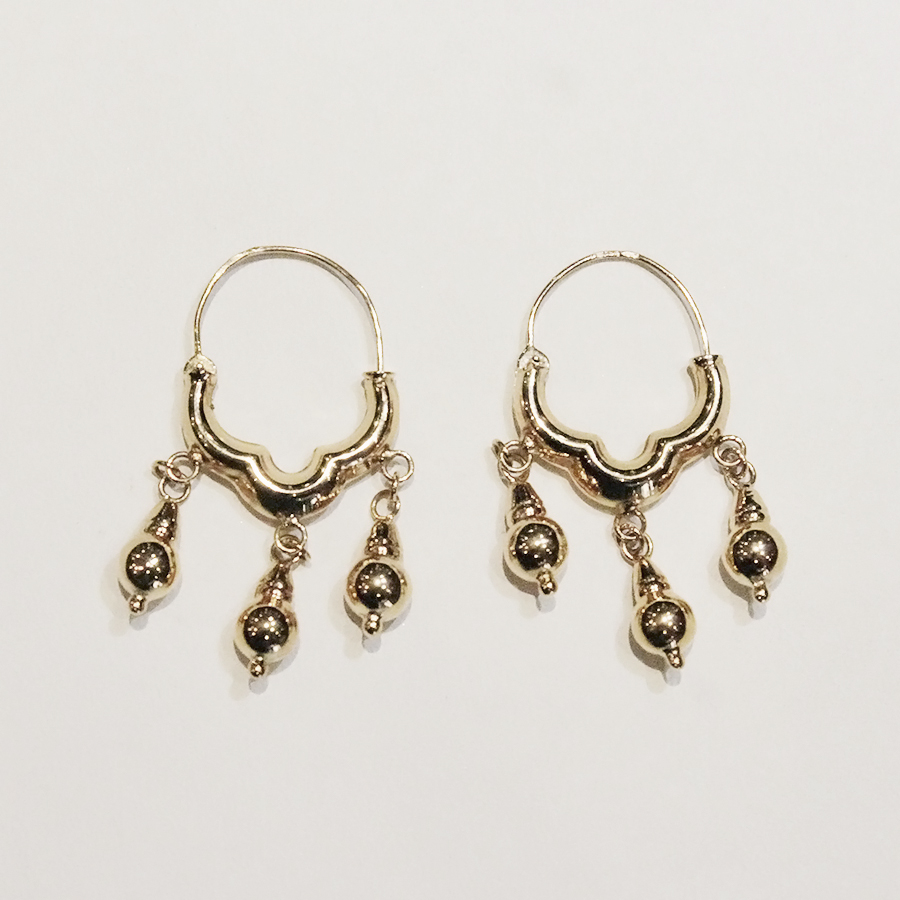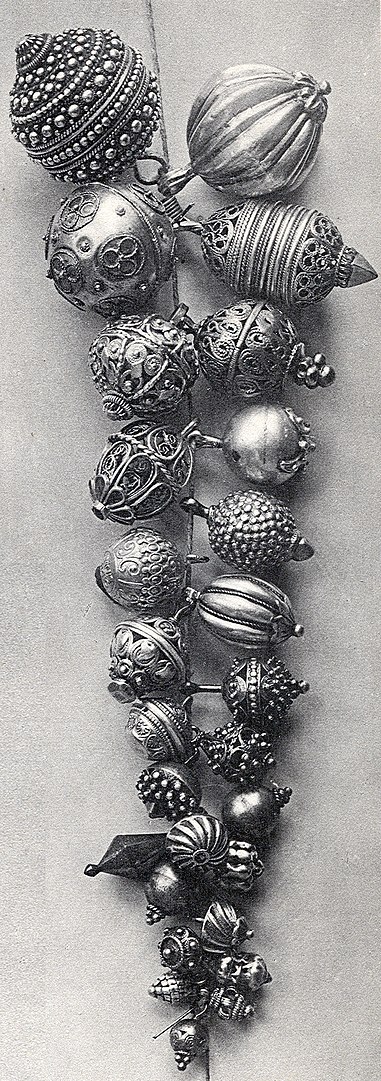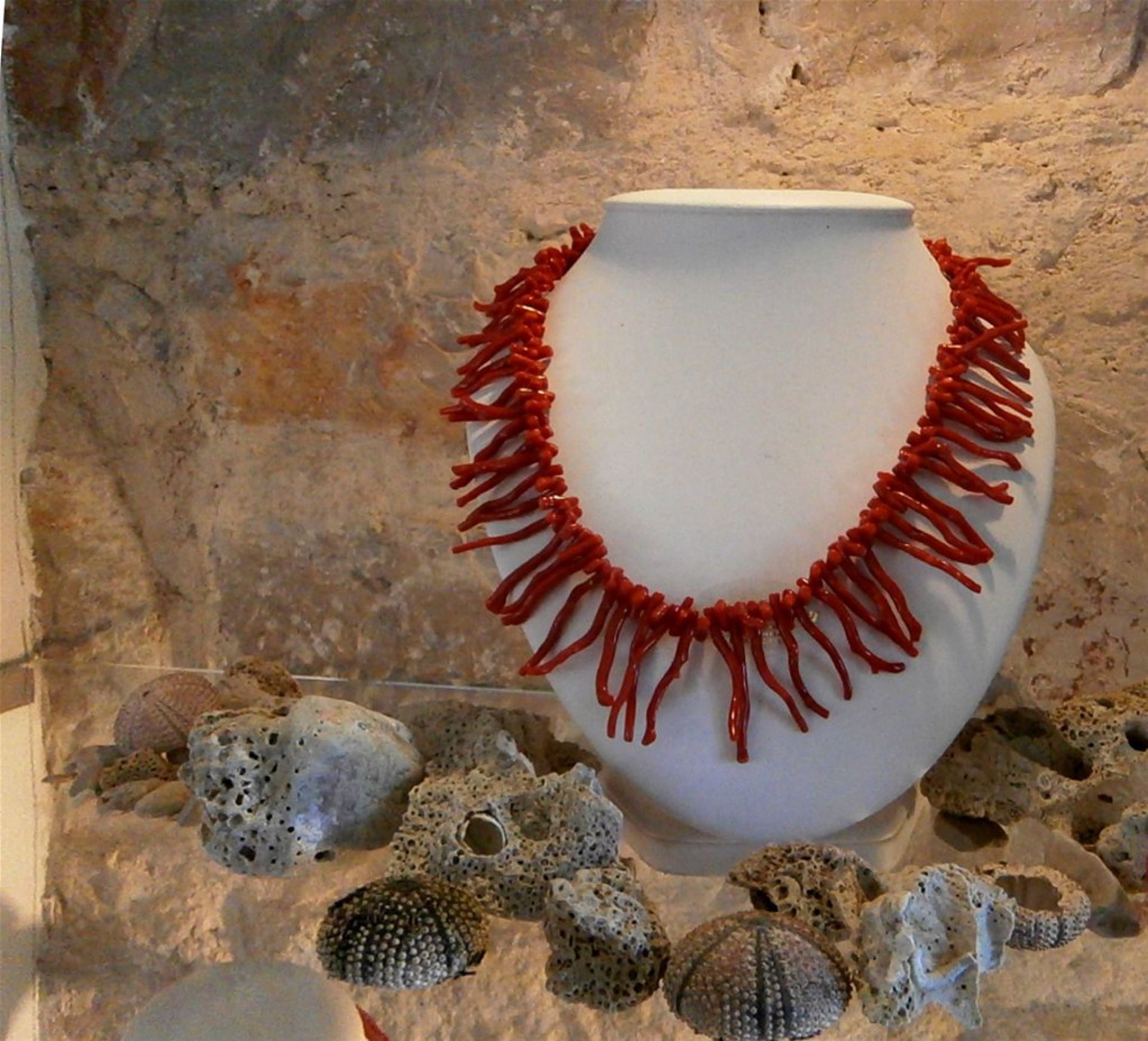Croatian Traditional Jewellery: Coral, Silver and Gold in Dalmatia
February 26th, 2022 - Following our feature dedicated to traditional jewellery of Istria, a look at the intricate filigree pieces traditionally worn in Dalmatia
In the first part of this series, we wrote about medieval jewellery discovered in Istria that has only recently seen a revival in the form of artisan replicas.
The traditional jewellery of Dalmatia, however, has historically been an integral part of folk costumes all over the region, and has been worn and treasured by generations of women up to the present day.
Let's take a look at some of the most prominent designs found in Dalmatia:
Pag beaded necklace and earrings / Paški peružini i ročini
First, a quick disclaimer: depending on who you ask, Pag island is a part of Kvarner, Dalmatia, neither, or both. We'll leave the people of Pag to define their cultural identity as they see fit, and will include the island in this particular feature based on the shared traits of traditional jewellery of Pag and that found in the rest of Dalmatia.
The traditional costume of Pag island largely owes its distinctive appearance to the triangular headdress worn by women, made of starched white linen and lined with intricate lace.
The Pag lace is a showstopper, but if you take a closer look, you’ll see that the ladies are also adorned in jewellery when clad in traditional garb. It’s been worn on Pag since the 16th century, and considering that there were no master goldsmiths living on the island at the time, the jewellery was imported from Venice.
 Pag folk costume / Image by Hotel Biser
Pag folk costume / Image by Hotel Biser
There are two distinct types of jewellery worn as part of the Pag folk costume. Delicate beads made in the filigree technique are called peružin; string a number of them together and you get a gorgeous necklace. Decorative hair pins featuring a single peružin were used to help keep the headdress in place, as seen on the above photo. It should be mentioned that the traditional peružini were once made to weigh exactly 123 grams each!
 A modern replica of Pag peružini / Image by Zlatarnica Jozef Gjoni
A modern replica of Pag peružini / Image by Zlatarnica Jozef Gjoni
The other distinctive piece found on Pag are the ročini, dangly bell-shaped earrings typically made of silver or gold.
 A modern replica of Pag ročini / Image by Zlatarnica Jozef Gjoni
A modern replica of Pag ročini / Image by Zlatarnica Jozef Gjoni
Šibenik button / Šibenski botun
Arguably the most popular piece on this list, the intricate Šibenik button used to be a decorative part of men’s folk costumes. These days, it’s one of the most recognisable symbols of Šibenik that doubles as an authentic souvenir. And while the motif is still seen in men’s accessories - tie clips, cufflinks - it’s not exclusive to gents anymore and is featured in women’s jewellery as well.
Similar to the Pag peružin, the Šibenik button is a hollow filigree bead composed of two half-spheres bonded together. Traditionally, the button used to be made of silver, but nowadays you’ll also find modern replicas made of gold, rose gold and aluminum. It's also called puce and toka, and was known to come in different sizes and designs depending on intended use.
 Various versions of Šibenik buttons
Various versions of Šibenik buttons
Even though there are metal buttons discovered in Dalmatia that date back to ancient times, the famous decorative bead only became widely adopted as a part of traditional garb around the 17th century.
As mentioned, they were only worn by men back then and were an indicator of social status and rank. The buttons were essentially comparable to military medals, as they were awarded to heroes and commanding officers from the region by Venetian generals based in Zadar.
Over time, the Šibenik button became so popular that a large number of artisans, from northern Dalmatia all the way to Albania in the south, specialised in the filigree technique so that they could create the intricate orbs.

Šibenik button earrings / Image by Zlatarnice Rodić Facebook
Zlarin coral / Zlarinski koralji
For a little intermezzo on our filigree-laden tour, we’re heading to Zlarin island right off the coast of Šibenik, historically known for quite a specific thing: coral.
People of Zlarin have dealt in coral harvesting and processing since the 14th century; while harvesting isn’t that common anymore, Zlarin is still home to a handful of skilled artisans creating unique coral jewellery.
 Red coral necklace / Šibenik Tourist Board
Red coral necklace / Šibenik Tourist Board
Red coral, also called precious coral, thrives in clean waters and grows at the depth of 30 to 200 metres. In its natural state, it’s covered in a crust that needs to be filed down for its intense red colour to show; the skeleton is then cut into smaller pieces, each of which gets filed, shaped and polished. Polishing is the most crucial stage, a process that can last up to a few days and results in a high shine. The colour has a range of 10-15 hues, varying from a light to a deep red.
The art of coral harvesting was a skill passed from father to son. Coral was historically harvested by trawling, using a tool called inženj, a wooden cross weighed down with a heavy stone and fitted with fishing nets. Coral would get entangled in the nets as they dragged across the seabed and break off when the nets were pulled out of the sea.
Fishermen from Zlarin participated in harvesting expeditions all over the Adriatic - sometimes straying even further, as far as Greece - and sold the catch on Sicily.
 Red coral / Zlarin Tourist Board
Red coral / Zlarin Tourist Board
After the fall of the Venetian Republic that controlled the coral trade in the Adriatic, the people of Zlarin were granted the exclusive right to coral fishery. Like elsewhere in the Mediterranean, coral was overharvested due to its value until it was nearly eradicated, and so the practice gradually became less common by the mid-20th century.
Nowadays, the island is home to two coral shops run by jewellery makers that keep the tradition alive. Zlarin is also about to get a Croatian Coral Centre, a state-of-the-art facility dedicated to the island’s history of coral harvesting that's set to open sometime soon.
Konavle earrings / Konavoske verižice & fjočice
We’re heading further south, to the Konavle area near Dubrovnik, the home of the elegant Konavle earrings.
The verižice hoop earrings from Konavle have a small pendant, typically a pearl or a coral bead. In the olden days, there was a social order to wearing jewellery in Konavle: young girls wore smaller earrings, and the older the women got, the bigger earrings they could wear. Young men were known to present their brides with the lovely hoops as a gift before their wedding day.
 Modern replica of Konavle earrings / Image by Zlatarnice Rodic Facebook
Modern replica of Konavle earrings / Image by Zlatarnice Rodic Facebook
Traditional jewellery was handled with care and kept in decorative wooden boxes or in special compartments in chests. The best pieces were only worn in rare special occasions, as jewellery was considered a family heirloom and was passed down from generation to generation.
Another type of earrings popular in Konavle are the so-called fjočice. Worn by brides on the day of their wedding and in the first year of marriage, the dangly earrings had several pendants made in gold filigree.
The Croatian Post paid homage to the lovely fjočice with their own postage stamp, created by designer Alenka Lalić from Zagreb:

Interestingly, the Konavle earrings weren’t actually made in the Konavle area, but were instead manufactured by goldsmiths in Dubrovnik. In the 19th and 20th centuries, the goldsmith workshops predominantly focused on traditional jewellery, driven by the increasing demand from Konavle and the wider Dubrovnik area.
Dubrovnik necklace / Dubrovačke peružine & kolarin
As Dubrovnik used to be a major goldsmithry centre from the medieval times to the mid-20th century, it doesn’t come as a surprise that the Pearl of the Adriatic has its own type of traditional jewellery.
You’ll surely recognise the peružin motif by now, the hollow filigree beads which in Dubrovnik were traditionally made of gold. Strung together, the beads make a lavish necklace called kolarin.

The kolarin were most commonly composed of 12, 14, 16 or 18 peružin beads, either simply strung on a silk ribbon, or connected with small golden links, pearls or coral beads. They were known to feature a heart-shaped pendant or a golden cross, altogether making a show-stopping piece typically worn on special occasions.
Nowadays, you'll most commonly find earrings or pendants featuring the Dubrovnik peružin bead.


